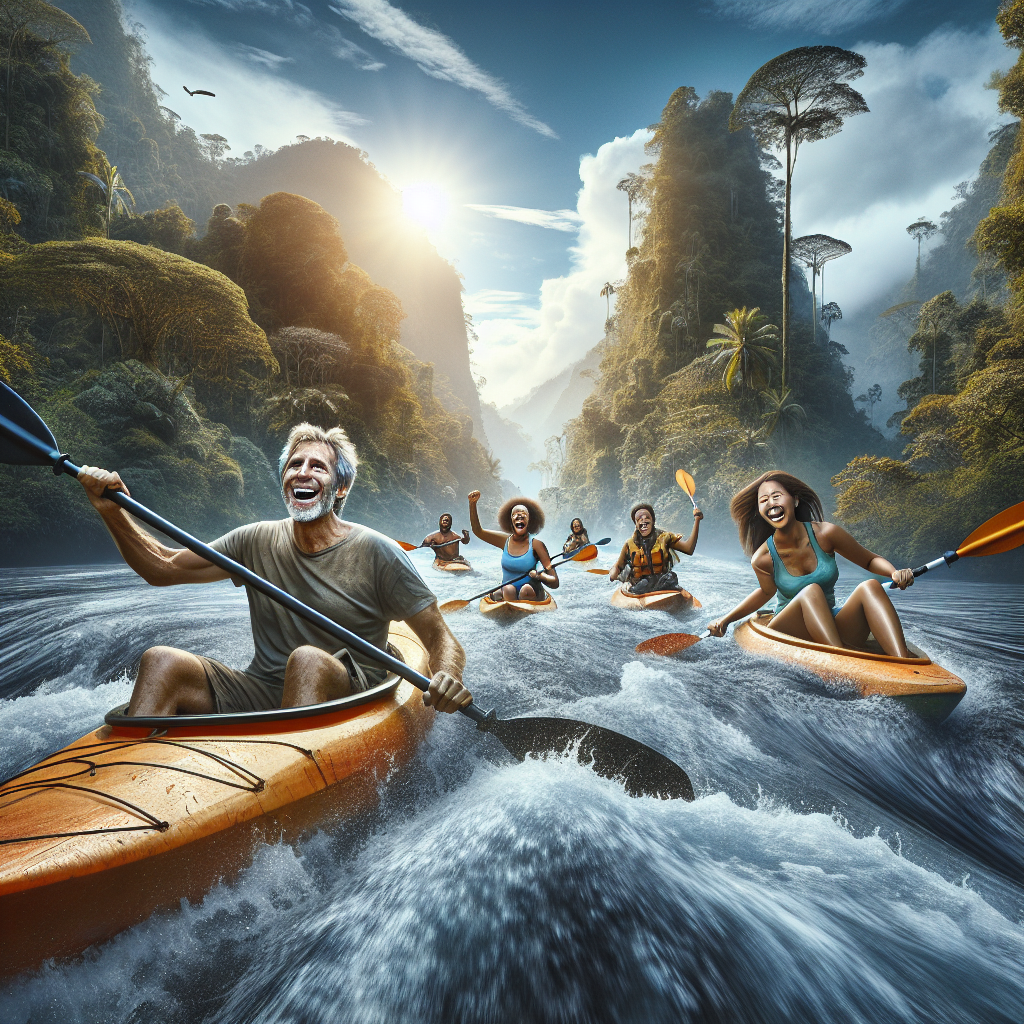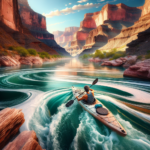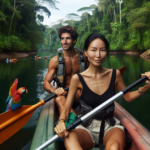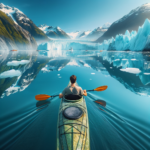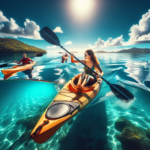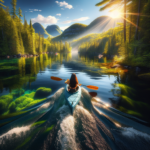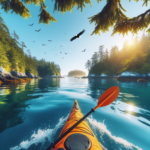Kayaking in Papua New Guinea Rivers
Introduction to Kayaking
Kayaking is an exhilarating outdoor activity that has gained immense popularity worldwide. It offers a unique blend of adventure, exercise, and a chance to connect with nature. Whether you’re navigating through serene lakes, challenging river rapids, or exploring coastal waters, kayaking provides a thrilling experience that appeals to both beginners and seasoned paddlers. The sport’s accessibility and the minimal equipment required make it an attractive option for those looking to embark on an outdoor adventure.
In this article, we will spotlight the unique features of kayaking in Papua New Guinea Rivers, a destination that promises an unforgettable experience for kayaking enthusiasts. From its diverse geography and rich cultural heritage to its pristine waters and abundant wildlife, Papua New Guinea offers a kayaking experience like no other. We’ll delve into the specifics of what makes this location a must-visit for anyone passionate about kayaking.
Kayaking in Papua New Guinea Rivers stands out due to its unique combination of natural beauty, challenging water conditions, and cultural significance. The rivers here are not just waterways; they are lifelines that have shaped the history and culture of the region. As you paddle through these waters, you’ll be surrounded by lush rainforests, towering mountains, and vibrant wildlife, making for a truly immersive experience.
Overview of Kayaking in Papua New Guinea Rivers
Papua New Guinea is an island nation located in the southwestern Pacific Ocean, known for its rugged terrain, dense rainforests, and rich biodiversity. The country’s rivers, such as the Sepik, Fly, and Wahgi, offer some of the best kayaking experiences in the world. These rivers flow through diverse landscapes, from highland valleys to coastal plains, providing a variety of kayaking conditions and challenges.
The climate in Papua New Guinea is tropical, with a wet season from December to March and a dry season from May to October. The best time to visit for kayaking is during the dry season when the water levels are more manageable, and the weather is relatively stable. However, the wet season can also offer thrilling experiences for those looking to tackle more challenging water conditions.
Accessing these kayaking spots is relatively straightforward, with major rivers being accessible from key towns and cities. For instance, the Sepik River can be accessed from the town of Wewak, while the Fly River is accessible from the town of Kiunga. Local tour operators offer guided kayaking trips, making it easier for visitors to explore these remote and pristine waterways.
Historically, water sports have played a significant role in the culture of Papua New Guinea. Traditional canoes and paddling techniques have been passed down through generations, and kayaking offers a modern twist on these age-old practices. Engaging with local communities and learning about their connection to the rivers can add a rich cultural dimension to your kayaking adventure.
Kayaking Conditions in Papua New Guinea Rivers
The rivers of Papua New Guinea offer a variety of kayaking conditions, catering to different skill levels and preferences. The Sepik River, for example, is one of the longest rivers in the country and offers a mix of calm stretches and challenging rapids. The Fly River, on the other hand, is known for its wide, meandering course and relatively gentle flow, making it suitable for beginners.
Weather conditions play a crucial role in determining the best times for kayaking. During the dry season, the weather is generally sunny and dry, with temperatures ranging from 25°C to 30°C (77°F to 86°F). This period offers the most stable conditions for kayaking, with lower water levels and fewer chances of sudden weather changes. The wet season, however, brings heavy rainfall and higher water levels, which can create more challenging and unpredictable conditions.
Tides and water currents are also important factors to consider. In coastal areas and estuaries, tidal changes can significantly impact water levels and flow rates. It’s essential to plan your kayaking trips around these tidal schedules to ensure a safe and enjoyable experience. Local guides and tour operators can provide valuable insights into the best times to kayak based on current conditions.
Environmental factors such as water temperature, visibility, and potential hazards like submerged rocks or fallen trees should also be taken into account. Wearing appropriate gear, such as a wetsuit or drysuit, can help you stay comfortable in varying water temperatures. Always be aware of your surroundings and follow safety guidelines to navigate these waters safely.
Top Spots for Kayaking in Papua New Guinea Rivers
Papua New Guinea boasts several top spots for kayaking, each offering unique features and experiences. The Sepik River is a must-visit for its stunning scenery and rich cultural heritage. As you paddle through its waters, you’ll encounter traditional villages, intricate wood carvings, and vibrant wildlife, making it a truly immersive experience.
The Fly River is another top spot, known for its wide, meandering course and relatively gentle flow. This river is ideal for beginners and those looking for a more relaxed kayaking experience. The surrounding landscapes are equally captivating, with lush rainforests, diverse wildlife, and opportunities for birdwatching.
For those seeking a more challenging adventure, the Wahgi River in the highlands offers thrilling rapids and fast-flowing waters. This river is best suited for experienced kayakers looking to test their skills and navigate through more demanding conditions. The highland scenery, with its towering mountains and dense forests, adds to the excitement and allure of this spot.
The best time of day for kayaking in these rivers is typically early morning or late afternoon when the weather is cooler, and the water conditions are more stable. The dry season, from May to October, is generally the best time of year to visit, offering the most favorable conditions for kayaking. However, each river has its unique charm and can be enjoyed year-round with proper planning and preparation.
Safety and Regulations
Safety is paramount when kayaking in Papua New Guinea Rivers. Local regulations and guidelines are in place to ensure the safety of all kayakers. It’s essential to familiarize yourself with these rules and adhere to them at all times. This includes wearing a life jacket, carrying a whistle or other signaling device, and staying within designated kayaking areas.
Recommended safety gear includes a helmet, especially when navigating through rapids or areas with potential hazards. A first aid kit, waterproof map, and a communication device such as a mobile phone or VHF radio are also essential. It’s crucial to check your equipment before each trip to ensure everything is in good working condition.
In case of emergency situations, such as capsizing or getting lost, it’s important to stay calm and follow established safety protocols. If you capsize, try to stay with your kayak and use it as a flotation device. Signal for help using your whistle or communication device and wait for assistance. Local guides and tour operators are well-versed in handling emergencies and can provide valuable support.
Always inform someone of your kayaking plans, including your intended route and expected return time. This ensures that someone is aware of your whereabouts and can alert authorities if you do not return as scheduled. Following these safety guidelines will help ensure a safe and enjoyable kayaking experience in Papua New Guinea Rivers.
Amenities and Accommodations
Papua New Guinea offers a range of amenities and accommodations to cater to kayaking enthusiasts. Rental facilities are available in key towns and cities, providing kayaks, paddles, life jackets, and other essential gear. Local guides and tour operators offer guided kayaking trips, making it easier for visitors to explore the rivers safely and enjoyably.
Accommodation options vary from camping sites along the riverbanks to hotels and lodges in nearby towns. For a more immersive experience, consider staying in traditional guesthouses within local villages. This not only provides a unique cultural experience but also supports local communities.
In addition to kayaking, there are plenty of other recreational activities to enjoy in the area. Hiking, birdwatching, and fishing are popular options, allowing you to explore the diverse landscapes and wildlife of Papua New Guinea. Cultural tours and village visits offer insights into the rich heritage and traditions of the local communities.
Whether you’re looking for a rustic camping experience or a more comfortable stay in a lodge, Papua New Guinea has something to offer for every type of traveler. Plan your trip in advance to ensure you have access to the amenities and accommodations that best suit your needs.
Environmental Considerations
Preserving the natural habitats and wildlife of Papua New Guinea is of utmost importance. As a kayaker, it’s essential to practice eco-friendly kayaking to minimize your impact on the environment. This includes avoiding littering, respecting wildlife, and staying on designated kayaking routes to prevent damage to sensitive ecosystems.
Guidelines for eco-friendly kayaking include using biodegradable soap for cleaning, packing out all trash, and avoiding the use of single-use plastics. It’s also important to be mindful of your noise levels to avoid disturbing wildlife. Observing animals from a distance and not feeding them helps maintain their natural behaviors and habitats.
Local conservation efforts and projects play a crucial role in protecting the environment. Supporting these initiatives through donations or volunteer work can make a significant difference. Many local organizations offer opportunities for visitors to get involved in conservation activities, such as tree planting, river clean-ups, and wildlife monitoring.
By following these eco-friendly practices and supporting local conservation efforts, you can help preserve the natural beauty and biodiversity of Papua New Guinea Rivers for future generations to enjoy. Your actions can contribute to the sustainability of this unique and pristine environment.
Highlights
When comparing kayaking in Papua New Guinea Rivers to other popular kayaking destinations, several unique features stand out. The country’s rich biodiversity, with its diverse range of flora and fauna, offers a kayaking experience that is hard to match. The rivers are home to a variety of wildlife, including birds, fish, and reptiles, providing ample opportunities for wildlife observation.
The geographical features of Papua New Guinea Rivers are equally impressive. From the towering mountains and dense rainforests of the highlands to the wide, meandering courses of the lowland rivers, the landscapes are incredibly diverse and captivating. This variety of terrains offers a range of kayaking conditions, from calm stretches to challenging rapids.
Historically, the rivers of Papua New Guinea have played a significant role in shaping the culture and traditions of the local communities. Traditional canoes and paddling techniques have been passed down through generations, adding a rich cultural dimension to the kayaking experience. Engaging with local communities and learning about their connection to the rivers can enhance your adventure.
Overall, kayaking in Papua New Guinea Rivers offers a unique blend of natural beauty, cultural heritage, and thrilling adventure. Whether you’re a beginner or an experienced kayaker, this destination promises an unforgettable experience that stands out from other kayaking locations around the world.
FAQ Section
- What is the best season to go kayaking in Papua New Guinea Rivers? The best season is during the dry season, from May to October, when the weather is more stable and water levels are manageable.
- Are there beginner-friendly spots for kayaking? Yes, the Fly River is ideal for beginners due to its gentle flow and wide course.
- What should I bring for a kayaking trip? Essential items include a life jacket, helmet, first aid kit, waterproof map, communication device, and appropriate clothing for the weather conditions.
- Are kayak rentals available? Yes, rental facilities are available in key towns and cities, providing kayaks, paddles, life jackets, and other essential gear.
- How can I participate in local conservation efforts? Many local organizations offer opportunities for visitors to get involved in conservation activities, such as tree planting, river clean-ups, and wildlife monitoring.
- Are guided kayaking tours available? Yes, local guides and tour operators offer guided kayaking trips, providing valuable insights and ensuring a safe and enjoyable experience.
- What safety measures are in place? Local regulations require wearing a life jacket, carrying a whistle or signaling device, and staying within designated kayaking areas. It’s also recommended to inform someone of your plans and carry a communication device.
Final Thoughts
Kayaking in Papua New Guinea Rivers is a premier destination for kayaking enthusiasts, offering a unique blend of natural beauty, cultural heritage, and thrilling adventure. The diverse landscapes, rich biodiversity, and challenging water conditions make it a must-visit for anyone passionate about kayaking. By respecting local guidelines and conservation efforts, you can help preserve this pristine environment for future generations.
Whether you’re navigating through the calm waters of the Fly River or tackling the rapids of the Wahgi River, the experience promises to be unforgettable. The opportunity to engage with local communities and learn about their connection to the rivers adds a rich cultural dimension to your adventure.
In conclusion, Papua New Guinea Rivers offer a kayaking experience like no other. The combination of stunning scenery, diverse wildlife, and cultural significance makes it a top destination for kayaking enthusiasts. So pack your gear, respect the environment, and get ready to explore the beauty and thrill of kayaking in Papua New Guinea Rivers.

